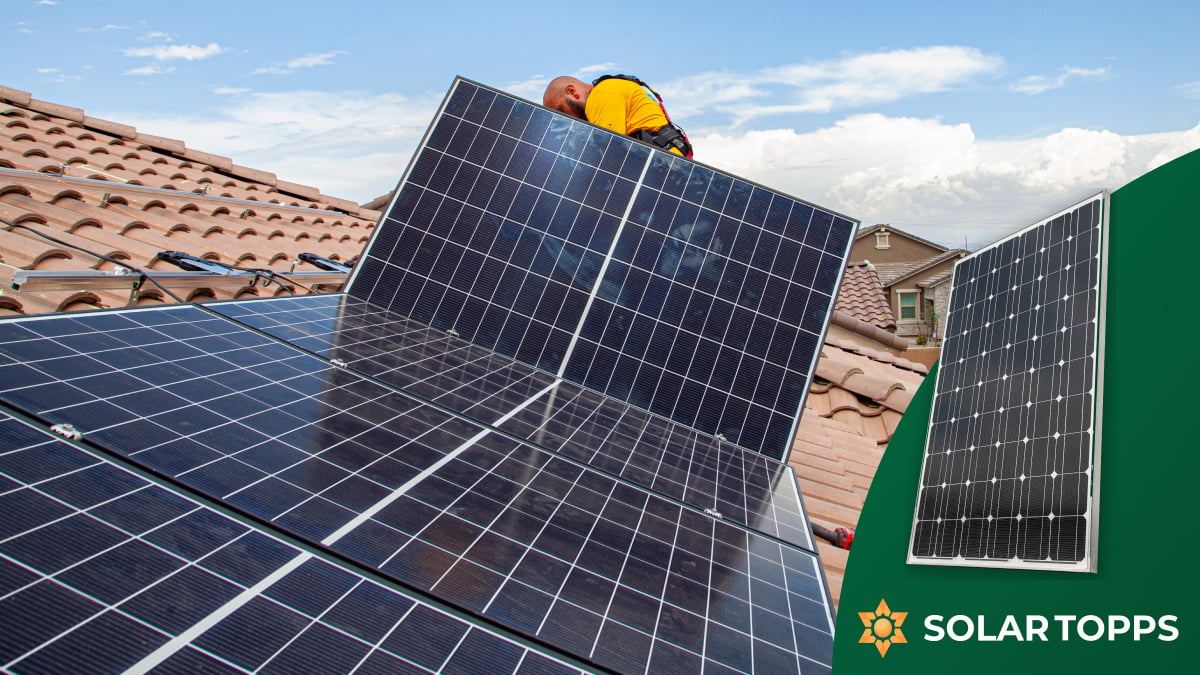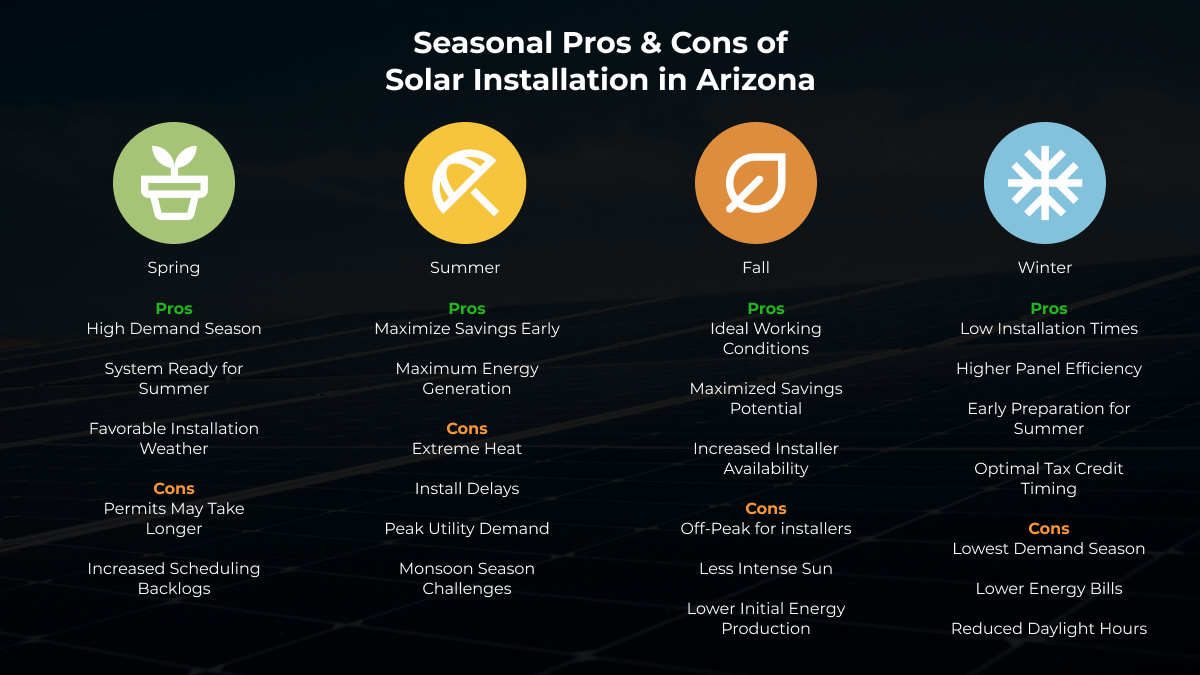When To Go Solar: What Time of Year to Go Solar in AZ
The Best Time of the Year to Install Solar Panels in AZ
Updated: September 26, 2025
Going solar in Arizona: why we recommend going solar quickly after you decide it is right for your family. Over the last several years, we have witnessed changes in utility rate structures, net-metering incentives, and rebate programs that made going solar “tomorrow” slightly less attractive than making the decision “today.”
Despite these changes, however, going solar in Arizona still makes a lot of economic sense for many homeowners throughout the state, and Solar Topps is proud to have the opportunity to serve them. The key difference with our company is if solar does not make sense for you and your family, we will let you know. We are part of your community and value, honest and open relationship with our neighbors over a sale. Although “yesterday” was a better time to go solar, customers who decide to go solar earlier in the year, between January and May, tend to be happier with their overall experience.
At Solar Topps, we serve the entire state of Arizona. However, we do specialize in the Phoenix Metro Area in cities like Scottsdale, Paradise Valley, Buckeye, Gilbert, Mesa, Chandler, Buckeye, Glendale, and other cities in the West Valley. If you want to Go Solar, please Contact Us. You can also fill out a Commercial or Residential Quote.
How much are Solar Panels for Homes?
The cost of installing solar panels on your home is not a one-size-fits-all figure. It varies significantly based on several critical factors, including system size, panel efficiency, installation complexity, and available incentives. Understanding these variables is crucial for homeowners to accurately assess their potential investment and long-term financial benefits.
Key Factors Determining Solar System Costs
- System Size
The size of the solar system you choose is one of the most significant factors impacting costs. Larger systems with higher energy output will naturally cost more upfront but may result in greater long-term savings by reducing reliance on traditional energy sources. - Panel Efficiency
Solar panels come in various efficiency ratings, which determine how effectively they convert sunlight into electricity. High-efficiency panels tend to have a higher initial cost but can generate more power in less space, making them ideal for homes with limited roof area. - Installation Complexity
The complexity of the installation process can also affect costs. Factors such as roof type, orientation, shading, and structural integrity can influence the difficulty of installation and the labor required, potentially increasing overall expenses. - Available Incentives and Rebates
Many homeowners can offset the cost of a solar system by taking advantage of federal, state, and local incentives. Tax credits, rebates, and net metering programs can significantly reduce the financial burden and shorten the payback period.
By carefully evaluating these factors and consulting with a qualified solar provider, homeowners can make informed decisions and optimize both their upfront investment and long-term energy savings.
Maximizing Savings with Solar Incentives
Selecting a reputable and experienced solar installation company is critical for maximizing the benefits of your solar investment. Begin by researching providers in your area and comparing their services, warranties, and customer reviews. Look for companies with a proven track record in designing and installing efficient and durable solar systems. Additionally, verify that they are licensed, insured, and certified by recognized organizations such as the North American Board of Certified Energy Practitioners (NABCEP). A reliable company will conduct a thorough site assessment, provide clear and honest pricing, and assist with navigating incentive programs and permitting requirements. Taking the time to choose the right company ensures a smooth installation process and the long-term functionality of your solar energy system.
Homeowners Benefit from Going Solar in Off-Peak Months
- Electric bills are lower this time of year, so customers waiting for installation pay little to the Utility company.
- During this time of year, fewer people choose solar, resulting in reduced demand on resources at Utilities, Cities, and HOAs. This allows for quicker processing of applications. With faster installations, homeowners can have their systems up and running before summer, enabling them to reduce electric bills when it matters most and start saving sooner.
- To take advantage of tax credits and incentives for going solar in Arizona, ensure your system is installed and operational by year-end to claim the tax credit promptly.
Additional Tips for Going Solar in Arizona
As solar adoption increases in Arizona, more homeowners are switching to save on their energy bills. But what are the best ways to save the most money? Every homeowner’s journey is unique, but there are universal ways to find the best system for your home.
Since 2009, Solar Topps has helped countless homeowners go solar effortlessly. Here are key factors we’ve observed over the years that contribute to a better solar experience. See some of our additional articles from the list below.
- Tip: Doing Your Research
- Tip: Getting Multiple Quotes from Qualified Solar Installers
- Tip: Reading the Fine Print
What Months of the Year Should You Install Solar Panels in Arizona?
Timing plays a crucial role in planning solar panel installation in Arizona. Thanks to the state’s abundant sunshine, solar systems can be installed any time of year, but certain seasons offer distinct advantages in terms of efficiency and convenience. The optimal period typically falls between October and March, encompassing late fall, winter, and early spring. During these months, milder temperatures create ideal working conditions for installers, minimizing delays caused by Arizona’s intense summer heat. Moreover, installing your solar panels during this timeframe ensures your system is ready to maximize energy production during the high-output summer months. Learn all about this and more with Solar Topps in Phoenix, AZ
Spring Months Going Solar:
Spring is the ideal season for solar panel installation, offering optimal conditions for efficiency and preparation. Key advantages include:
- Favorable Weather: Mild temperatures in spring reduce the risk of weather-related delays, ensuring a smooth installation process.
- Peak Energy Preparation: Installing in the spring allows your system to be fully operational before summer, when energy demand and sunlight hours are at their highest.
- Maximized ROI: Strategic timing helps homeowners capitalize on increased energy production, optimizing returns on investment.
- Avoiding Backlogs: By scheduling installation before peak periods, you minimize delays and ensure a streamlined process.
This approach ensures a reliable, efficient installation while positioning your system for maximum performance during high-demand months.
Benefits of Solar Energy During Summer
Summer is the perfect time to maximize solar energy. Longer daylight hours allow solar panels to produce more power, reducing reliance on the grid and cutting utility costs. Excess energy can be stored or credited through net metering, providing year-round savings. Upgrading your system before peak summer rates ensures greater energy independence and financial benefits.
Increased Efficiency Through Advanced Solar Technologies
Modern advancements in solar technology have significantly improved the efficiency of solar panels, particularly during summer. Enhanced panel designs and battery storage solutions ensure maximum energy capture and utilization, even during extreme heat. Investing in these technologies helps homeowners and businesses optimize their energy output during peak sunlight hours.
Environmental Impact of Solar Energy
Transitioning to solar energy during the summer months not only reduces electricity costs but also minimizes environmental impact. Solar energy generation produces no greenhouse gas emissions, making it a cleaner alternative to traditional energy sources. By using solar power, individuals and organizations contribute to the fight against climate change while promoting sustainability.
The Fall and Winter Months: Going Solar: Does Demand Change?
During the fall and winter months, solar energy production naturally decreases due to shorter daylight hours and less intense sunlight. However, this does not mean going solar is any less valuable. Modern solar panels are designed to perform efficiently even in low-light conditions, ensuring consistent energy generation. Additionally, many households consume less electricity during these cooler months, which can balance out the reduced solar output.
Year-Round Practicality of Solar Panels
For systems equipped with energy storage, excess energy generated in sunnier months can be utilized, maintaining energy independence and offsetting utility costs throughout the year. This highlights the year-round practicality and benefits of a well-designed solar energy system.
Environmental Benefits of Solar Energy in the Summer
Solar energy systems significantly contribute to reducing greenhouse gas emissions by replacing electricity derived from fossil fuels with clean, renewable energy. This transition decreases carbon footprints both at the individual and community levels. Furthermore, solar energy production requires no water, unlike traditional energy generation methods, thereby conserving an essential resource and minimizing environmental impacts.
In Conclusion, It’s Always Good to Go Solar
Always remember that you are not alone in this process. Whether you choose Solar Topps or another installer, our priority is ensuring you receive the best value. Feel free to call, text or chat online for a free, no obligation conversation. We look forward to helping you go solar without regrets.













